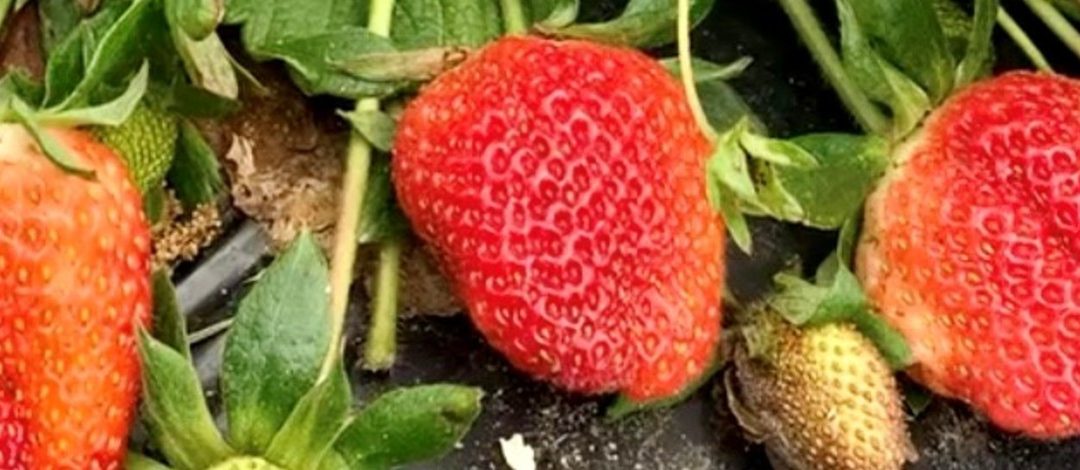
by Larry Williams | Apr 10, 2025
Strawberries are being harvested in North Florida now and sweet onions will be harvested soon. Spring is the time to harvest these crops, however; fall is the time to plant these crops in our area.
Planting time and variety selection are keys to sweet onion and strawberry success in North Florida.

Sweet onions almost ready for harvest in a Calhoun County garden. Credit: Joe Leonard.
We can produce large, tasty sweet onions in North Florida. When using the correct varieties and when planted at the right time, we can produce bulbs up to four inches in diameter with flavor that rivals the famous Vidalia onions.
To be successful at growing large sweet onion bulbs, you have to set out plants in the fall. Waiting to plant in spring, as is done up north, results in small onions. As a matter of fact, onions planted after the first of the year make puny little bulbs. To produce large bulbing onions, you should plant your transplants during October to mid-November. Otherwise, you may get big green onion plants verses big bulbs.
In order to be successful with growing large onions in our area, you have to select the correct varieties. Basically, you need to use varieties of “short-day” onions such as ‘Grano’, ‘Granex’, ‘Texas Grano’, ‘Excel’ or ‘Tropicana Red’. ‘Granex’ is the variety that is used for producing Vidalia onions and St. Augustine Sweets.
Some gardeners seed their onions in September in order to have plants ready for transplanting to the garden later in the fall. Others buy the plants of these varieties during the
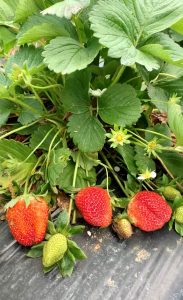
Strawberries ready to harvest in spring. Credit: Larry Williams
fall. These onion plants should be placed four to five inches apart in rows that are twelve to twenty-four inches apart. Fertilization is required during the winter and particularly as the onion bulbs begin to size up in the spring. Onions grow well during our relatively mild winters and will be ready for harvest in early May, as the tops of the plants begin to turn yellow and fall over.
Many gardeners fail with strawberries in North Florida by waiting to plant in spring and by planting the wrong varieties for our area. In Florida, strawberries are treated as annuals
. They are planted during October and November. Like onions, strawberry plants are cold hardy, producing a full sized plant by spring and yielding a crop during March through May. Once you’ve harvested the berries, do away with the plants. It’s not worth trying to carry strawberry plants through our hot, wet summers. Start next fall with fresh plants.
Use only “short-day” strawberry varieties. These include ‘Camarosa’, ‘Sweet Charlie’, ‘Festival’, ‘Chandler’, ‘Dover’, ‘Selva’, ‘Sequoia’, ‘Tioga’, ‘Oso Grande’, ‘Florida Belle’ and ‘Florida 90’. “Everbearing” varieties of strawberries, which are frequently advertised, are not well suited for Florida. More info is available at http://edis.ifas.ufl.edu/hs403.
Enjoy the spring harvest season of these two delicious crops, but plant them in the fall.
For more information on growing your own vegetables, contact the UF/IFAS Extension Office in your County or visit http://edis.ifas.ufl.edu/topic_vegetable_gardening.
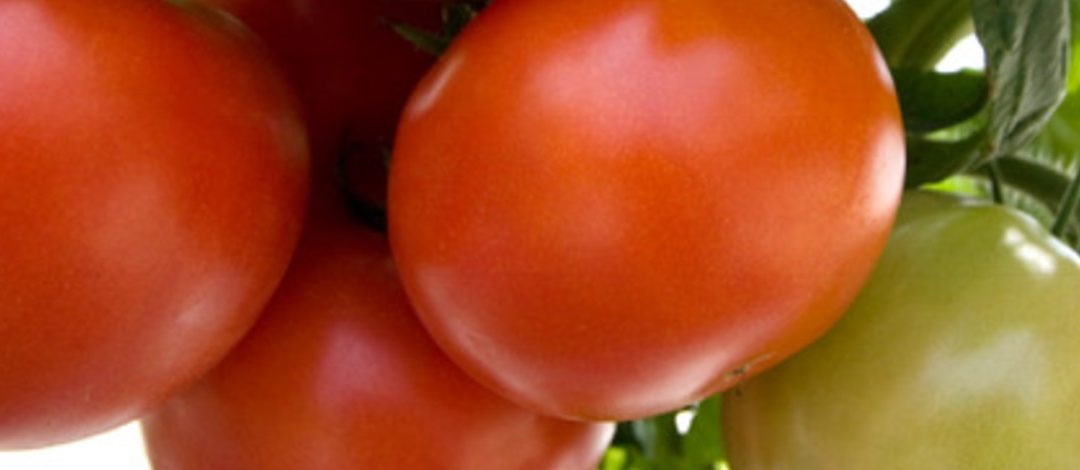
by Larry Williams | Feb 11, 2025
There are common reasons for failure with vegetable gardens in North Florida. One of those reasons is planting at the wrong time of year. We can grow vegetables year-round here in North Florida but it’s important to plant and grow the right vegetable during the right season. Most warm-season vegetables, such as tomato and cucumber, are planted and grow when frosts and freezes are not likely to happen. While the cool-season crops, such as strawberry and onion, are planted and grow during the cooler months of fall, winter and early spring. We have to be careful to select the correct varieties, as well.
Many gardeners overdo it in fertilizing and liming their gardens, which can result in failure. I’ve seen gardeners create problems in their gardens by watering too much or at the wrong time of day. Some gardeners use too much of a good thing such as mushroom compost, wood ashes, Epsom salt or copper fungicides in their gardens, creating lasting problems. And, unfortunately, too many gardeners don’t know how to identify beneficial insects versus pest insects and misuse insecticides as a result.
To be successful with vegetable gardening in North Florida, a person needs to know these basics. This is the kind of information I will cover in the free, two-hour seminar titled Home Vegetable Gardening 101.
The Home Vegetable Gardening 101 seminar is scheduled for Saturday, March 1, 10 a.m. to 12 noon at the UF/IFAS Extension Office in Crestview. The address is 3098 Airport Road in Crestview, FL. Please use the registration form below to register or call (850) 689-5850. Space is limited.
The registration form is here: https://forms.office.com/r/YTqt192MYB
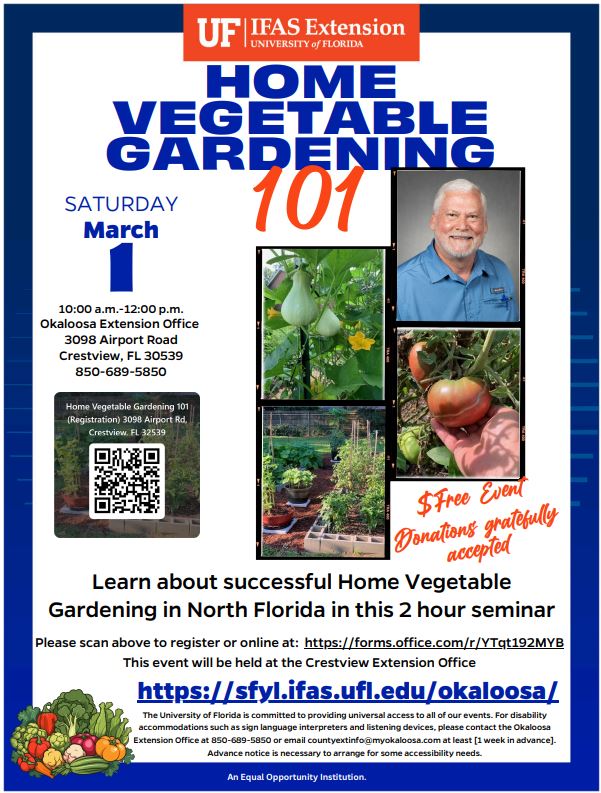
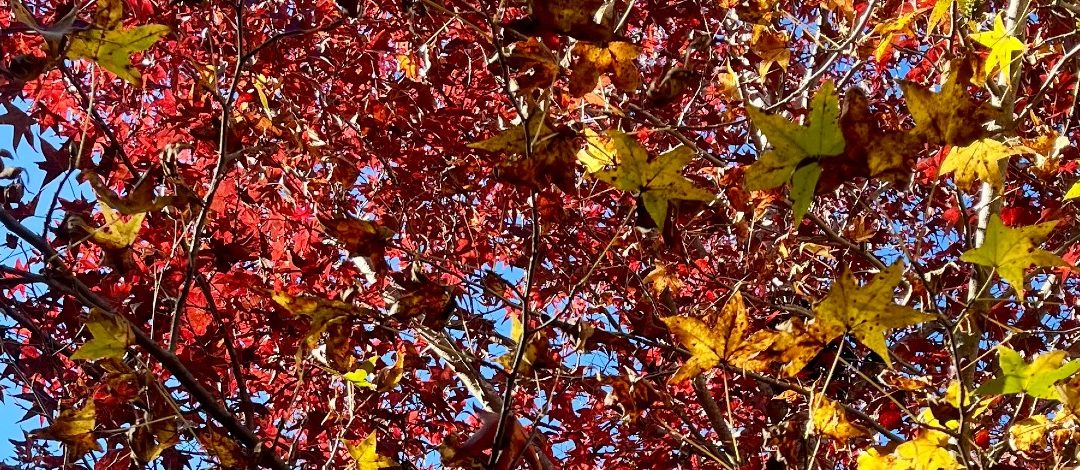
by Larry Williams | Jan 2, 2025
In the Christmas story as recorded in the book of Matthew, wise men presented gifts to baby Jesus. Two of these gifts were frankincense and myrrh. These are costly perfume oils derived from certain trees found in parts of the Middle East.
According to Dr. Kim Coder, urban forestry specialist with the UGA Extension Service, there are more than 36 trees mentioned throughout the Old and New Testaments. Some of these trees have relatives living here in Florida.
In an article on this topic, Coder said, “The trees most people think of from the Bible are the Cedars of Lebanon.” Lebanon cedars are true cedars like the Deodar cedar found planted in some North Florida communities. He said, “Today a relict (species of an earlier time) grove of 400 trees still survives on Mount Lebanon that is more than 2000 years old.”
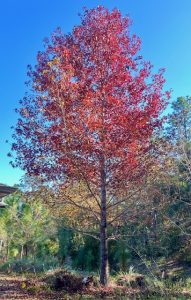
Sweetgum tree fall foliage at Okaloosa County Extension Office. Credit: Larry Williams
The sycamore common to North Florida does not grow in Palestine. “The sycamore of the Bible is the sycamore fig,” Coder explained. The fruit of the sycamore fig is smaller and less sweet as compared to the table fig and was considered food for the poor. Another name used by some people in the United States for sycamore is plane tree but Coder said that the plane trees referred to in the Bible were the flowering viburnums and oriental plane trees in the Middle East. “Also mentioned is the sycamine, which is the black mulberry,” Coder said.
The poplar trees of the Bible are the same white poplar that you can find growing in some areas of North Florida but it is more commonly found north of Florida. “But poplar also means
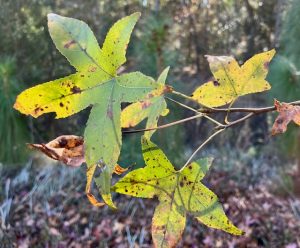
Sweetgum star-shaped leaves in fall. Credit: Larry Williams
snowbell, which is related to our native snowbells,” Coder said. “The name poplar was used for two distinctly different trees.”
One tree from the Bible that is common in North Florida is balm. “The balm, or balm of Gilead, was the sweetgum tree,” Coder said. The sweetgum of the Middle East is almost identical to our sweetgum tree that grows all over North Florida. Coder said that there is a tree named “Balm of Gilead” that grows in the northern United States but it is native only to North America. “Our sweetgum is a botanical link to the sweetgum of the Bible,” he said.
Ebony wood, which is also mentioned in the Bible, was imported for carvings and decorations. “Ebony is related to our common persimmon,” Coder said.
Florida’s forests are filled with close relatives of a number of Biblical trees. “There are many links to our cultural heritage stemming from the Bible,” Coder said. “Touch a sweetgum leaf and you hold a piece of Christian and Jewish history.”
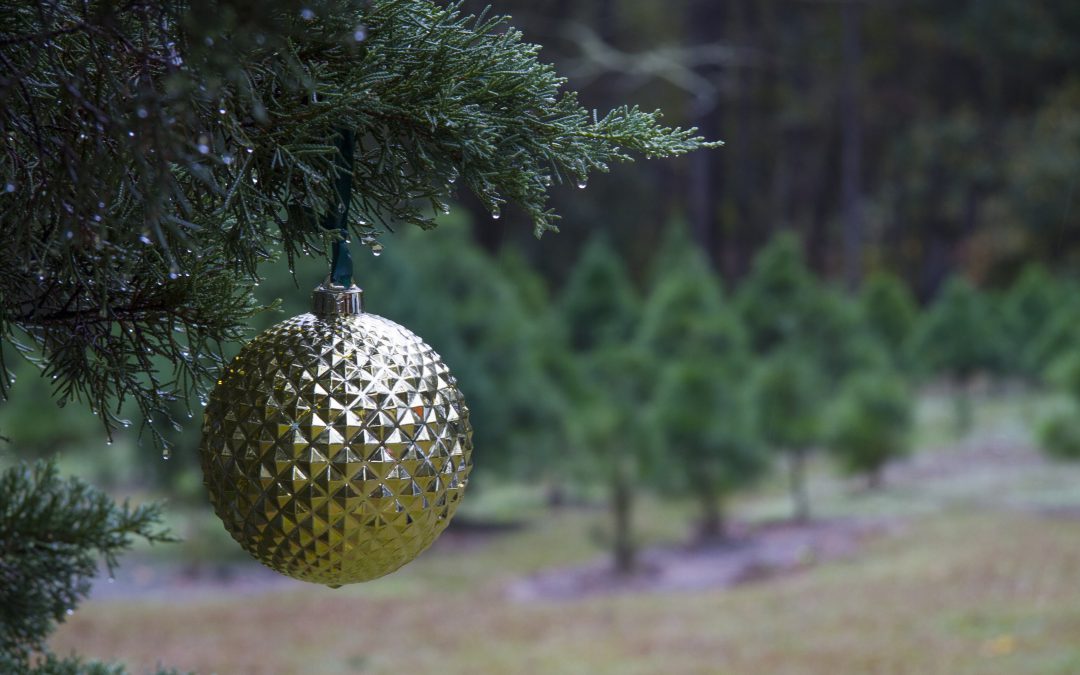
by Larry Williams | Dec 13, 2024

Christmas cactus in bloom. Credit: Larry Williams
Christmas cactus, poinsettia and amaryllis are some of the flowering holiday plants that can be kept for enjoyment after the holidays are gone.
These plants require bright, indirect light. They should be placed close to a sunny window and turned once a week to prevent them from leaning toward the light. In rooms with poor light, place your plants under incandescent or fluorescent lamps, but not too close to incandescent light due to the excessive heat.
Keep temperature cool for best results with plants associated with the holidays. Ideal temperatures are lower than found in most homes. But your plants should do well if the day temperature range is 65°F degrees to 75°F but cooler at night.
It’s important to keep the plants evenly moist. This includes the Christmas cactus since it is not a typical cactus. Avoid moisture extremes of letting the plants become bone-dry or waterlogged.
The flowers will eventually fade on your holiday plants. Once this happens, remove the faded flowers. This will improve the appearance and prevent the plant from setting seed, which will provide more energy for growth.
The poinsettia eventually will begin dropping its leaves. This is normal. The plant is going into a resting stage. When it begins to drop its leaves, decrease watering until you’re watering only enough to keep the root and stems from drying out excessively. In April, prune the stems to about six inches, resume normal watering, fertilize and place where it will get plenty of light but not direct sun. Forcing poinsettias to re-flower for the Christmas Season can be a challenge within the average home environment.
With amaryllis, each flower lasts only a few days. But since multiple flowers are produced, plants may remain in flower for a week or more. After the last flower fades, remove the bloom stalk. Leaves begin to emerge at flowering and continue to elongate after flowering when additional leaves may appear. It is essential that the leaves remain on the bulb so that it can manufacture “foods” needed for re-flowering. It should be kept under high indoor light and watered and fertilized regularly.
When the danger of frost has passed, amaryllis can be placed outdoors and grown under light shade. By late summer, the leaves will begin to die and the bulb enters a resting stage. Reduce watering, store in a cool dry place, and allow the bulb to rest two to three months. Resume watering and the plant should re-flower in four to six weeks. Amaryllis can also be planted outside in our climate and will re-flower each year with proper maintenance.

by Larry Williams | Oct 31, 2024
So far, our fall has been unusually dry with warmer temperatures. Even though our average annual rainfall is around sixty-two inches per year, we don’t always receive rain exactly when we need it. There are times when we need to apply additional water. During dry weather, employ the following water management practices to improve the water efficiency of your lawn and landscape.
Mulching helps conserve water. On bare ground, about sixty percent of the water can be lost through evaporation. A two to three-inch layer of mulch will help hold onto the water so the plants can use it. Try to mulch the entire root zone when possible or at least apply mulch all the way around the plants out to the end of the branches.

Irrigate on as needed basis during dry periods. Credit: Larry Williams
When watering, a thorough soaking to wet the soil to a depth of six to eight inches is much better for plants than light, frequent watering. Three to five gallons of water applied to one spot under the canopy of trees or shrubs should thoroughly saturate the root zone in that location. During dry periods, as a general rule), twenty-five percent of the root system, when watered thoroughly, can absorb all the water a plant requires at any given time.
When watering lawns, apply one inch of water per week when we are not getting rain. Although many sprinklers have irrigation rates of ¼ inch per hour, some may apply up to one inch per hour. Measure your irrigation rate and uniformity by placing several open-top containers of the same size under the sprinkler and see how long it takes to apply a known amount of water such as ½ inch.
An efficient irrigation program on turf should not begin until the lawn grass shows signs of moisture stress. Symptoms include a dull and bluish-green color and leaf blades folding. The most efficient time to irrigate is between sunset and sunrise because of less evaporation, less wind and lower temperatures. Early morning is the next most effective time to irrigate while midday is the least efficient.
Avoid fertilizing drought-stressed plants. Fertilizers are chemical salts and will dehydrate roots when water is in short supply. If you need to apply a pesticide, make certain the plant is not wilted at the time and spray during early morning or late afternoon. You should also avoid unnecessary pruning of plants during drought. Pruning encourages new growth, which has a high demand for water.
For more information on watering efficiently and drought tolerant plants, contact the UF/IFAS Extension Office in your county or visit the following website: http://gardeningsolutions.ifas.ufl.edu/care/irrigation.












